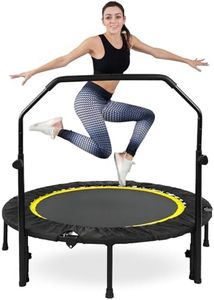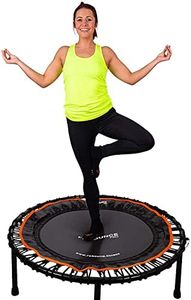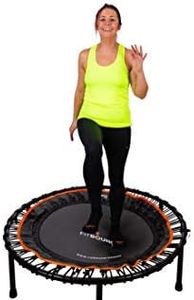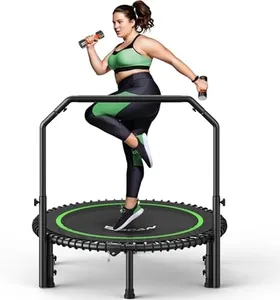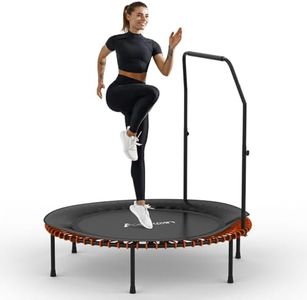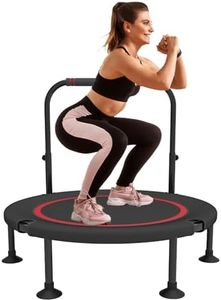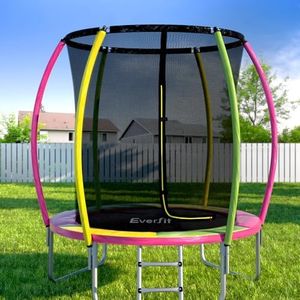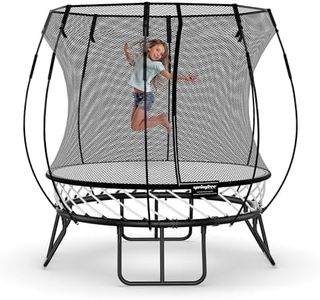We Use CookiesWe use cookies to enhance the security, performance,
functionality and for analytical and promotional activities. By continuing to browse this site you
are agreeing to our privacy policy
10 Best Fitness Trampolines
From leading brands and best sellers available on the web.Buying Guide for the Best Fitness Trampolines
Choosing the right fitness trampoline is all about matching the features of the trampoline to your fitness needs and home environment. Whether you're looking for a fun way to exercise, aiming to improve your balance and coordination, or seeking a low-impact cardio workout, a fitness trampoline can offer a great solution. The key is to understand which specifications matter most, what they mean, and how they translate into real-world use. By focusing on what you want to achieve and where you'll use your trampoline, you can decide on the features that will make your workouts both safe and effective.Diameter/SizeDiameter refers to the width of the trampoline from edge to edge, usually measured in inches or centimeters. It's important because it determines how much space you'll have for your workout moves and where you can place the trampoline. Smaller diameters (around 36-40 inches) are best for individual use and smaller spaces, making them ideal for quick cardio jumps or balance exercises. Medium sizes (40-48 inches) offer a bit more space for varied movements like twisting or side steps. Larger diameters (over 48 inches) give maximum exercise room and comfort but take up more floor space. Your choice should depend on the exercises you plan to do and the available space in your home.
Weight CapacityWeight capacity tells you how much weight the trampoline can safely support. This is important for both safety and the durability of the trampoline. Lower-weight capacities (up to 200 lbs) are generally suited for lighter users. Medium capacities (200-300 lbs) accommodate most adults, while higher capacities (over 300 lbs) are for heavier users or for more intensive workouts. Always choose a trampoline with a capacity higher than your current weight to ensure stability and longevity.
Spring Type / Suspension SystemThe spring type or suspension system in a fitness trampoline comes in two main forms: metal springs or bungee cords. Metal springs offer a firmer, more traditional bounce, but can be noisier and harsher on the joints. Bungee cords provide a quieter and softer rebound, which is gentler on the joints and often preferred for low-impact fitness. If you need intense, fast workouts, metal springs might be suitable; for comfort and low-impact exercise, bungee systems are a better fit. Think about your joint health and the intensity of your planned exercise when choosing.
Adjustable HandlebarSome fitness trampolines provide a handlebar for extra stability, which is especially useful for beginners or for more dynamic routines. The adjustability of the handlebar matters because it ensures a comfortable grip at your height and allows for different exercise types. If you want to use the trampoline for balance work, or if you're new to rebounding, a handlebar can boost your confidence and safety. If you’re more advanced or want to do exercises that require full motion, you might opt for a model without a handle.
Mat MaterialThe mat material is what you actually jump on, and it plays a role in durability, comfort, and safety. Higher-quality mats are made from strong, woven materials like polypropylene, offering a better bounce and longer lifespan. Lower-quality mats may wear out faster or feel rougher underfoot. If you plan to use your trampoline frequently or for high-intensity exercise, look for stronger mat materials for safety and comfort. For occasional, light use, material choice is less critical but still worth considering.
Foldability/PortabilityFoldability and portability determine how easy it is to store or move the trampoline. Some trampolines fold in half or have removable legs, making them easy to tuck away when not in use. If you have limited space or plan to move the trampoline between rooms, make foldability a priority. For a permanent workout space, this feature is less important.
Stability/Feet DesignStability mainly comes from the way the legs or feet of the trampoline are designed. Wide, rubber-capped, or non-slip feet offer better grip and prevent the trampoline from sliding, which is important for safety during vigorous workouts. If you live in a space with smooth or hard floors, stability features are crucial. For carpeted areas, this may be less of a concern.
